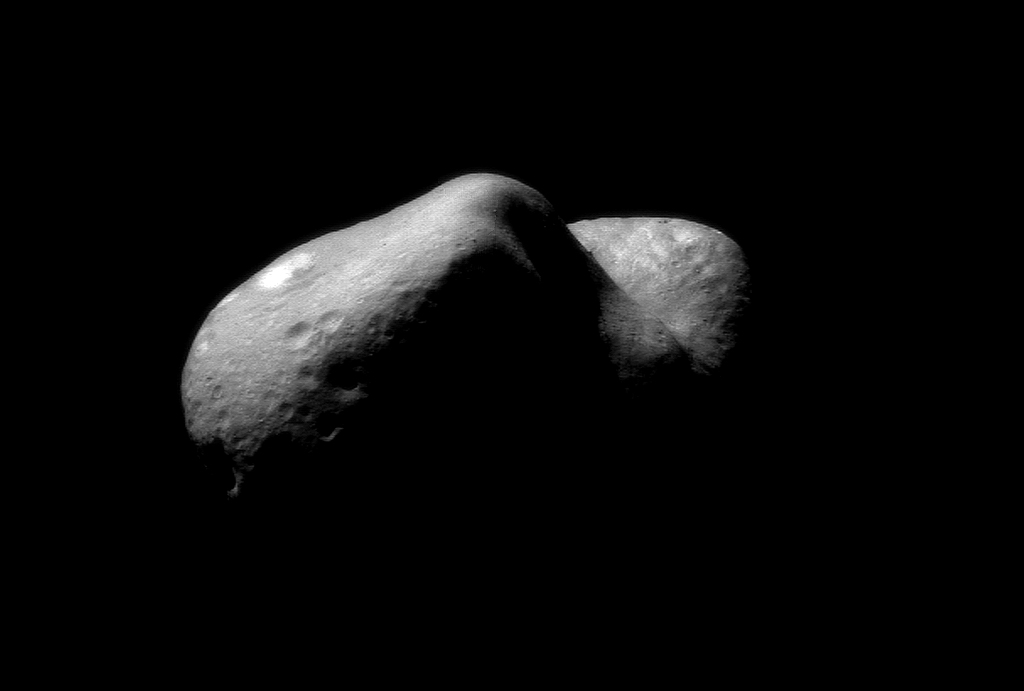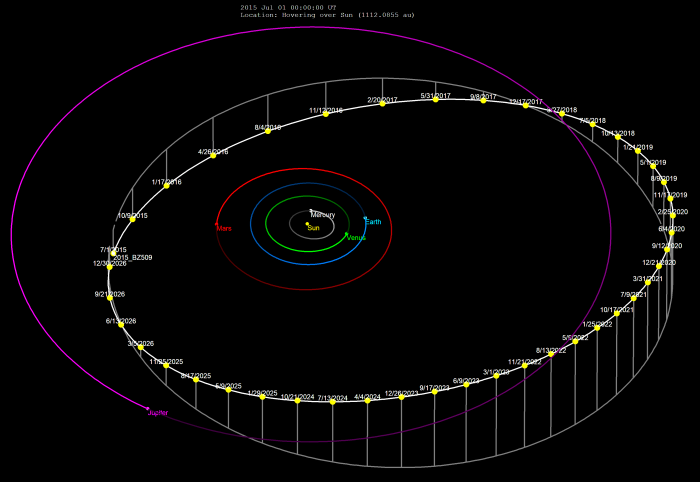
Looks like Oumuamua is not our only interstellar visitor anymore. Meet 2015 BZ509, nicknamed BZ, a permanent asteroid whose origins are possibly (more than likely) from outside our very own solar system.
This asteroid is incredibly interesting and will be a fixture in our very own solar system for years to come.
Who are we? We find that we live on an insignificant planet of a humdrum star lost in a galaxy tucked away in some forgotten corner of a universe in which there are far more galaxies than people. – Carl Sagan
Let’s go back to October of 2017 when scientists discovered a foreign and strangely-shaped asteroid in our solar system. When it was discovered the folks over at NASA were able to look at its trajectory was hyperbolic and was not at all influenced by the gravitational pull of the planets in our solar system, which pointed to its origins being interstellar (meaning it was created and spit out from somewhere outside of our solar system).
It was officially named Oumuamua, a Hawaiian word meaning scout or messenger since it’s origins are so foreign to us. Unfortunately, Oumuamua is moving so fast that we would never be able to send a probe (or even a lander) out to it to study it and learn about it while we can before it leaves our solar system.
Well, we have learned that Oumuamua is no longer our only interstellar asteroid. 2015 BZ509 was actually discovered in late 2014 (hence the 2015 part of the name) and was found to share Jupiter’s orbit around the sun. You might be thinking that since we discovered this asteroid almost 4 years ago this might not be current news, but that’s where you would be wrong.

2015 BZ509-orbit by Tomruen via Wikimedia Commons is licensed under CC-BY-SA 4.0 https://creativecommons.org/licenses/by-sa/4.0/deed.en
A new study was released Monday about this asteroid and the space community is super excited about it. This study really focused on BZ and found that its origins are most likely not from our solar system. When BZ509 was first discovered it wowed scientists initially for a couple of reasons; it shares an orbital path with Jupiter and in a way plays chicken with our biggest planet, and its orbit is actually retrograde and different than most of the other objects orbiting the sun.
Retrograde orbits are orbits that go in the opposite direction of the sun’s rotation. Most of our planets have a prograde orbit with the exception of Venus and Uranus. Like we said above, BZ has a retrograde orbit, meaning it goes the opposite way around the sun. The video below does a great job in showing the oddity of BZ’s orbit compared to the planets in our solar system. Its orbit is actually what has pointed scientists to believe that it was not originally from our solar system.
One of the lead scientists of the study, Fathi Namouni, said in the statement, “If 2015 BZ509 were a native of our system, it should have had the same original direction as all of the other planets and asteroids, inherited from the cloud of gas and dust that formed them.” (her statement can be found here). This research was conducted by doing a computer-generated model that traced BZ’s orbit back millions of years to try to figure out where this asteroid came from and why its orbit is so different.
They found that BZ more than likely entered our solar system over 4 billion years ago. According to this study, our solar system was young enough that it would not be able to produce a retrograde orbit on its own, so the only way BZ could have gotten its orbit is that it was not originally from here and came from somewhere else.
| 2015 BZ509 Stats | |
| Discovery Date | 26-Nov-14 |
| Planet Category | Retrograde, asteroid, Jupiter co-orbit |
| Orbital Period | 11.6 years |
| Obit | Retrograde |
| Aphelion | 7.0925 AU |
| Perihelion | 3.1824 AU |
| Magnitude (H) (luminosity) | 16 |
This study, which is peer-reviewed and is generally accepted, has not been proven… yet. If this theory about BZ509 is correct then it is very likely that our solar system has more interstellar visitors that we don’t know about yet. The most likely area to find some hidden interstellar asteroid would be the region beyond Neptune and Pluto according to the study. Thus far, we know of only two interstellar objects in our solar system; Oumuamua and now BZ509, but the more that we discover these objects the more we can learn about the universe outside of our solar system.
Impacts of BZ509’s Discovery
Just like with the discovery of Oumuamua, BZ509’s discovery is important for our understanding of the universe outside of our solar system. With Oumuamua scientists are stuck merely observing the asteroid from our telesco[es on the ground and in space since the alien asteroid is moving so quickly that we wouldn’t be able to keep up with it. Bz509 (which will be named soon by the International Astronomical Union, or IAU) is much more of a permanent fixture in our solar system, which means at some point we could feasibly get a probe near it to study its makeup and look at it closer. It may even be possible, at some point in the future, to determine where BZ actually originated from and learn more about that star that “birthed” it.
Like we mentioned before, this discovery also points to the likelihood of other interstellar objects in our sun’s orbit. It is incredibly likely that we have material and asteroids from other stars and distant planets caught up in the sun’s gravitational pull, but the likelihood of being able to pinpoint them will be extremely difficult. BZ509 has been in our solar system for billions of years and we are just now realizing that it is an interstellar object. Hopefully, this discovery will help scientists determine better ways to track asteroids, giving us a better chance at learning to learn about their origins.









